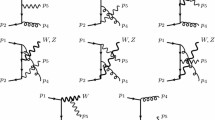Summary
Using the dual-resonance model of Kikkawa and Sato, we calculate the contributions of the one-closed-loop graph to the electromagnetic form factor and the virtual-Compton-scattering amplitude of theI=1,I 3=1, 0+ meson. It will be shown that the resulting form factors behave like 1/(−t) ast → −∞, and the virtual-Compton-scattering amplitudeA (see eq. (4.2)) satisfies the Bjorken’s scaling law and has the fixed-pole structure required by the Fubini-Gell-Mann sum rule. Obviously this model is gauge invariant.
Riassunto
Facendo uso del modello della risonanza duale di Kikkawa e Sato si calcolano i contributi dei diagrammi con un’ansa chiusa al fattore di forma elettromagnetico e all’ampiezza dello scattering di Compton virtuale del mesoneI=1,I 3=1, 0+. Si mostra che i fattori di forma risultanti si comportano come 1/(−t) quandot → 0, e che l’ampiezza dello scattering di Compton virtualeA (vedi eq. (4.2)) soddisfa la legge di scala di Bjorken e la struttura di polo fisso richiesta dalla regola di somma di Fubini-Gell-Mann. Ovviamente questo modello è invariante di gauge.
Реэюме
Испольэуя модель дуальных реэонансов Киккава и Сато, мы вычисляем вклады графика с одной эамкнутой петлей в злектромагнитный форм-фактор и амплитуду виртуального комптоновского рассеяния для меэонаI=1,I 3= 1, 0+. Будет покаэано, что полученные форм-факторы ведут себя, как 1/(−t) при t → −∞, и амплитуда виртуального комптоновского рассеяния A удовлетворяет эакону подобия Бьёркена и имеет структуру с фиксированным полюсом, что требуется согласно правилу сумм Фубини-Гелл-Манна. Эта модель является калибровочноинвар иантной.
Similar content being viewed by others
Literatur
For a review of this progress, see, for example,M. Jacob:Duality in strong interaction physics, CERN preprint, Ref. TH. 1010-CERN. As one of the nice reviews involving the dual-resonance model, we citeM. Ida:Lectures on the dual-resonance model, Kyoto University preprint, KUNS-187.
M. Bander:Nucl. Phys.,13 B, 587 (1969);R. C. Brower andM. B. Halpern:Phys. Rev.,182, 1779 (1969);M. Ademollo andE. D. Giudice:Nuovo Cimento,63 A, 639 (1969);R. C. Brower andJ. H. Weis:Phys. Rev.,188, 2495 (1969);R. C. Brower, A. Rabl andJ. H. Weis:Nuovo Cimento,65 A, 654 (1970);H. Sugawara: Tokyo University of Education preprint (1969);I. Ohba:Progr. Theor. Phys.,42, 432 (1969);P. V. Landshoff andJ. C. Polkinghorne:Nucl. Phys.,19 B, 432 (1970);B. Humpert: University of Cambridge preprint, HEP 70-4.
Y. Oyanagi:Nucl. Phys.,14 B, 375 (1969);H. Suura:Phys. Rev. Lett.,23, 551 (1969);M. Namiki andI. Ohba:Progr. Theor. Phys.,42, 1166 (1969);N. Tokuda andY. Oyanagi:Phys. Rev. D,1, 2626 (1970);B. Humpert: University of Cambridge preprint, HEP 70-6.
R. C. Brower andJ. H. Weis:Phys. Rev.,188, 2486 (1969);I. S. Gerstein, K. Gottfried andK. Huang:Phys. Rev. Lett.,24, 294 (1970).
With the possible exception of ref.(4).
R. P. Feynman:Phys. Rev. Lett.,23, 1415 (1969); see also talk given at theThird International Conference on High-Energy Collisions Held at State University of New York, Stony Brook, Sept. 1969.
J. D. Bjorken andE. A. Paschos:Phys. Rev.,185, 1975 (1969);S. D. Drell, D. J. Levy andT. M. Yan:Phys. Rev. Lett.,22, 744 (1969);Phys. Rev.,187, 2159 (1969).
As for the application of the parton model to the electromagnetic mass differences of hadrons, seeT. Muta:Progr. Theor. Phys.,44, 1022 (1970). For the extension of the parton model to the hadron-hadron collisions, see, for example,A. Niégawa:Progr. Theor. Phys.,44, 977 (1970);Y. Okumura:Progr. Theor. Phys.,44, 995 (1970);H. Fritzsch:Lett. Nuovo Cimento,4, 291 (1970).
K. Kikkawa andH. Sato:Phys. Lett.,32 B, 280 (1970); University of Tokyo preprint, UT-51 (1970).
Here the photon is not included in the argument of «duality», contrary to the papers in ref. (2,3).
J. D. Bjorken:Phys. Rev.,179, 1547 (1969).
J. B. Bronzan, I. S. Gerstein, B. W. Lee andF. E. Low:Phys. Rev. Lett.,18, 32 (1967);Phys. Rev.,157, 1448 (1967);V. Singh:Phys. Rev. Lett.,18, 36 (1967).
S. Fubini:Nuovo Cimento,43 A, 475 (1966).
See the second paper cited in ref. (1).
See ref.(10). See alsoK. Kikkawa andH. Sato: University of Tokyo preprint, UT-47 (1970).
D. J. Gross, A. Neveu, J. Scherk andJ. Schwarz:Phys. Rev. D,2, 697 (1970).
See the second paper cited in ref. (17). See alsoM. Ida, H. Matsumoto andS. Yazaki:Progr. Theor. Phys.,44, 456 (1970).
Some amplitudes which appear in the following are convergent in a certain region ofs andt, while the others have the well-known end-point divergence asu → 1 (22). In the latter case, we can avoid the difficulty, for example, by performing the regularization method (23) and/or the renormalization method (19,24).
K. Bardakci, M. B. Halpern andJ. A. Shapiro:Phys. Rev.,185, 1910 (1969);D. Amati, C. Bouchiat andJ. L. Gervais:Lett. Nuovo Cimento,2, 399 (1969).
Second paper cited in ref. (17).
A. Neveu andJ. Scherk:Phys. Rev. D,1, 2355 (1970).
R. J. Eden, P. V. Landshoff, D. I. Olive andJ. C. Polkinghorne:The Analytic S-Matrix (London, 1966).
K. Kikkawa:Phys. Rev.,187, 2249 (1969).
M. Imachi, T. Matsuoka, K. Ninomiya andS. Sawada:Progr. Theor. Phys.,38, 1198 (1967);40, 353 (1968).
This paragraph had its origin in a discussion with Profs.J. Iizuka andZ. Maki. I would like to thank them for this helpful discussion.
T. Muta andY. Simizu: Kyoto University preprint, to be published;H. B. Nielsen andL. Susskind: CERN preprint, Ref. TH. 1230-CERN.
Author information
Authors and Affiliations
Additional information
This article was originally submitted toLettere al Nuovo Cimento on 16th October, 1970, and then resubmitted toIl Nuovo Cimento, according to the advice of the referee.
Rights and permissions
About this article
Cite this article
Niégawa, A. Form factor and virtual-compton-scattering amplitude in the kikkawa-sato model (Dual-resonance model of hadron with gauge bosons). Nuov Cim A 4, 883–903 (1971). https://doi.org/10.1007/BF02731525
Received:
Published:
Issue Date:
DOI: https://doi.org/10.1007/BF02731525



